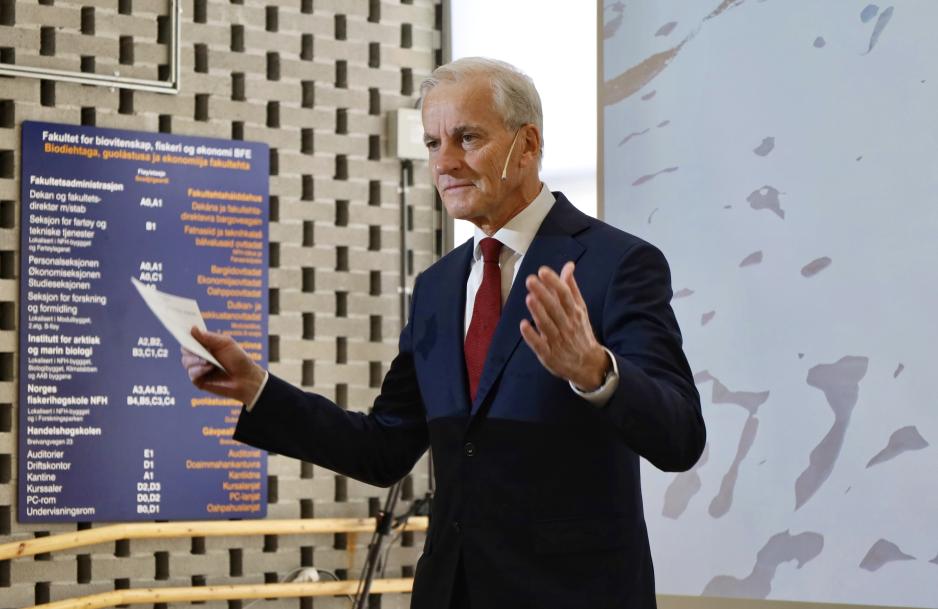Op-ed: Norway Under Pressure: A New Strategy for the High North in 2025

The Norwegian Prime Minister visited Tromsø on Tuesday, revealing NOK 1 billion for the research project Arctic Ocean 2050. Østhagen writes in this op-ed that Norway's new High North Strategy is clear on Norway maintaining its position in the Arctic through funding research, among other things. (Photo: Astri Edvardsen)
Op-ed: In a world where security policy is intertwined with all other policy areas and geo-economic rationales diverge from purely economic considerations, Norway must navigate increasing interest and interference in its northern regions. The Arctic and High North are increasingly arenas for power projection, geo-economics, and symbolic politics, writes researcher Andreas Østhagen.
This is an op-ed written by an external contributor. All views expressed are the author's own.
This article is based on a longer report, available here (in Norwegian).
In 2025, great power rivalry defines international politics. Regions where these powers intersect are particularly vulnerable to rivalry and conflict, exemplified by the High North and the wider Arctic region.
Climate change, resource potential, and economic opportunities are key drivers of these dynamics, interacting with security policy interests and status-seeking behaviours among major global powers.
Norway stands centrally in this context. The High North positions Norway as a regional power, supported by its northern capacities in infrastructure, business, academia, and defence. Svalbard remains the Arctic's crown jewel.
However, Norway faces increasing challenges. In a world where security policy is intertwined with all other policy areas and geo-economic rationales diverge from purely economic considerations, Norway must navigate increasing interest and interference in its northern regions. The Arctic and High North are increasingly arenas for power projection, geo-economics, and symbolic politics.
In 2025, great power rivalry defines international politics.
New strategy: "Norway in the North"
Announced on August 26, 2025, the government's new High North Strategy arrives at a crucial time. It establishes a revised course for Norwegian High North policy and updates the description of the increasingly precarious situation regarding security and regional development in the High North.
Announcements preceding the strategy included references to the "Total Preparedness Report," the "National Transport Plan 2025-2036," decisions concerning a new fibre cable to Svalbard and Jan Mayen, the location of NATO's new air operations centre near Bodø, and comprehensive plans for the Armed Forces, including a new "Finnmark Brigade."
A clearer description of reality
Alongside new formulations, goals, and measures, the strategy offers insights for researchers focused on security and geopolitics. Some points are more explicit than before (author’s translation, emphasis added):
- "Growth, development, and preparedness in Eastern Finnmark are not isolated conditions but a prerequisite for national security and sovereignty" (p. 6).
- Due to a "sharp increase in global interest in the Arctic," "national presence, knowledge, and leadership are more important than ever" (p. 6).
- "Norway shall be a leader in the alliance on knowledge about Russian and Chinese activity in our immediate areas and will contribute actively to NATO processes with our expertise" (p. 16).
The government's new High North Strategy arrives at a crucial time.
Other noteworthy points include:
- "Norway should have a restrictive attitude towards Chinese activity in the High North" (p. 17).
- The government “will help shape EU initiatives of importance to the High North and participate in cooperation to safeguard Norwegian interests” (p. 16).
- "Cooperation in the North-Nordic region shall be strengthened, especially in the areas of transport, emergency preparedness, and mobility" (p. 17).
- "The counties in the north will have an important role in cooperation across borders" (p. 16).
- "The government sees it as crucial to promote supplier development related to the Armed Forces' investments and activities in the North" (p. 23).
- "The Power and Industry Promise is also about ensuring that Statnett prioritizes grid development in the north, with particular emphasis on Finnmark, and that geopolitical considerations are emphasized in the assessment of increased grid and production capacity in Finnmark" (p. 40).
- "The government has expressed its support for the start of new operations in the Syd-Varanger mines and established a contact point for the owner company in the policy apparatus" (p. 41).
Foreign and security policy
In foreign and security policy, the strategy is clear on maintaining Norway's position through funding research, protecting the Law of the Sea, utilising the Arctic Council, and actively contributing to NATO, rather than charting radically new directions.
This aligns with long-standing Norwegian foreign and security policy priorities, albeit with a more pronounced emphasis on "shaping" and "leading" NATO and EU policies.
The most evident change is the explicit statement that Norway should adopt a restrictive approach towards Chinese activity in the North. This reflects concerns about, for example, Chinese research in Svalbard and potential investments in critical infrastructure in Northern Norway, now clearly articulated.
Defense and instruments for regional development are appropriately emphasised, given the security dynamics in the North concerning Russia. However, a broader geopolitical context will increasingly shape Norway's room for manoeuvre in the High North.
A restrictive approach towards Chinese activity in the North.
A separate strategy for foreign policy?
The focus on the Arctic Ocean 2050 research program exemplifies addressing this, as it represents a core Norwegian interest. Norwegian research communities must be global leaders in understanding their own region. Yet, foreign and security policy goals are diluted within the broader High North policies.
A separate foreign policy strategy could outline how Norway intends to manage increasing pressure in the High North and the Arctic, encompassing Svalbard and geopolitical challenges, which are referenced to the Parliament Report from 2024.
Another key question is whether this strategy will foster greater general awareness and interest in High North issues beyond the region itself. Despite being designated as Norway's most important "strategic focus area" by successive governments over the past two decades, it remains surprisingly poorly understood in the rest of the country.
The Norwegian High North is more than just a resource base or a defence region for containing Russia and managing population decline. It has evolved into a critical geopolitical arena and resource for Norway amidst a fundamental shift in international politics.



